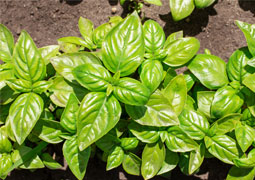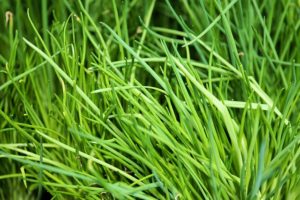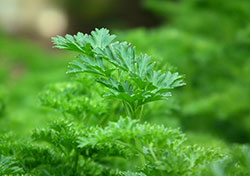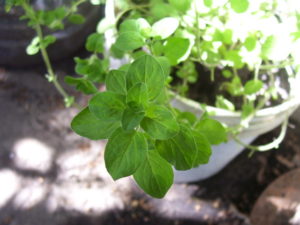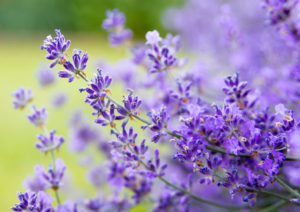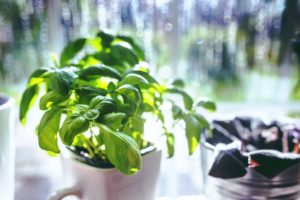Basil is one of the most versatile herbs to have around in your kitchen. I’m willing to bet you even have one in your pantry right now. With an herb this useful, it’s probably just better to have your very own fresh supply. Good thing I’m teaching you how to grow basil today.
From pasta to stir-fry, you can trust this herb in tying up all the flavors in your dish. No one can’t deny how basil deserves the title of the super herb. From American and Italian cuisines to the more complicated Asian dishes, basil is a kitchen staple.
I’ve had a pleasant time growing them in my home garden so I thought I could share some tips with you guys. Let’s start!
Basil is one of the easiest herbs to grow. And it’s super low-maintenance too. This one’s perfect for beginners. And don’t worry if you have a small space for gardening at home. This culinary herb grows perfectly well in containers!
Get ready for a very rewarding plant!
Planting Basil
When is the best time to plant basil?
The best time to plant basil is during the late spring when all the dangers of frost have already passed.
Basil is a warm-weather plant so when you plant them in cold weather, you’ll see that they’d be very stunted and generally won’t grow very well. This applies to all varieties of basil.
Once planted, basil will continue to grow up until the first frost.
Where can I find basil seeds?
The best way to start a basil plant is by planting seeds. One packet of basil seeds is more than enough.
See to it that you’ll only use good quality ones. Fungal diseases that might attack your basil plant in the future may come from infected and low-quality seeds.
You can find basil seeds on your local grocery store, garden center, plant nursery, and local farm. I got mine online. It’s just more convenient that way.
Should I grow basil in a pot or grow it in the ground?
You can grow basil in either pots or garden beds. If you have a garden bed, good for you! You have a great set-up for growing basil. And good news for those who only have a limited space because basil is also fit for container gardening.
When growing in pots, here’s what to do. For basil plants, a one and a half gallon round pot will do. You can grow up to 4 basil plants in that container.
Try asking your local nursery if they have pots available. They usually just throw it away at the end of the season, so you might score one for free. They use very durable containers so you know their pots will last for a long time.
But you can always order one online if you can’t wait until then. I got mine from Amazon, they’re kinda old now but I still use them because they’re still in good shape and works perfectly fine.
These sturdy pots were very inexpensive and were totally worth the investment.
How do I prepare the soil?
Now that you have your pot with you or your garden bed is free from weeds and dirt, it’s time to prepare the soil.
This is a very important step to ensure large and delicious tasting basil leaves.
Basil thrives in a moist and fertile soil. You’ll need well-drained soil with a pH of 6.0 to 7.5.
You can test your soil at your local garden center or a local college. Alternatively, use a soil ph strip. Loam soil is also the ideal soil for growing basil.
There are two ways to prepare your soil.
- Fill your container with good quality potting-specific soil. You can buy one or make it at home yourself. Just mix in compost, perlite, and vermiculite in equal parts.
If you can’t wait until then, try this one. I got it from Amazon and generally use it for container gardening. Loosen the soil with your hands and fill the container until there’s a one-inch left. You can add some sand to make the soil loose for easy drainage.
- For garden beds, just make sure the soil conditions stated above are met. Prepare your garden bed a month in advance. Do this by working the compost into the topsoil.
See? It’s easy! Now we’re ready for planting.
How do I plant the basil?
We’re using sweet basil, the most common culinary basil, for today. You can use other varieties but if you’re a beginner, I recommend planting this one first. It’s the easiest variety to grow.
When planting in the garden bed, follow these steps.
- Sow the seeds evenly directly into the ground one-fourth inch deep.
- Cover with soil.
- Keep it moist. Within five to seven days, seedlings will emerge. It’s the D-shaped one with 2 broad seed leaves.
- Once this happens, thin them so they can be 6-12 inches apart, I’ll discuss thinning more on later. Spacing is important when planting basil. You want to make sure your plant has adequate space for airflow.
- Add two to three inches of mulch around the plants to help retain moisture as well as avoiding weed problems.
When planting in the container, here’s what you do.
- Sow seeds in growing trays first.
- Wait for it to germinate. This happens between 7 to 14 days.
- Once your seedlings are established, transplant them into the containers.
- Space them evenly. I find that you can put up to 4 seedlings in one pot.
- Place in a warm and sunny location. Water generously.
Growing Basil
How and when do I thin my basil plant?
Thinning is mostly done when you planted basil on a garden bed. Once you see your seedlings develop 2 to 3 pairs of true leaves, you can now thin and transplant them 6 to 12 inches apart.
How and when do I prune my basil plant?
First things first, some of your basil plants will definitely go to seed. Some varieties seed even faster than the others.
When this happens, the production of the leaves will decrease. The fragrance of your basil leaves will also diminish.
When your basil goes to seed, the plant’s energy is actually focused on growing the flowers and not on the leaves.
You don’t want this if you want to continue or prolong harvesting. I want my basil to continue to grow throughout the growing season so I prune them.
Here’s what you need to do.
The moment you see your plants starting or already flowering, all you need to do is cut them off.
Pick out all the basil stems that contain the little flowers.
Pinch off all the flower stalks that you see.
When you let the basil flower to continue to grow, the plant will just stop growing.
We don’t want that. Alternatively, you can just opt to not grow the varieties that love to blossom fast such as the Spicy Globe basil and the Thai basil.
Though both of these are varieties are more hands-on than others, they’re very rewarding plants to grow.
Basically, the main takeaway is to keep the flowers away throughout the growing season.
The best time for your basil to go to seed is at the end of the growing season. Let the bees go crazy on them and collect your seeds for the next growing season!
How much water does my basil plant really need?
As I’ve said earlier, basil plants are ridiculously low maintenance. But one thing it should never experience is water stress. So water regularly and deeply every 7 to 10 days. This is done to ensure that its roots are receiving enough moisture.
I suggest you water at the base and do it in the early morning so the plant will be dry by nighttime.
If you planted them in containers, always check the soil for moisture. Basil plants grown in containers generally dry out faster than those grown in garden beds. Adjust and make sure to water them more frequently.
Remember to only use containers with enough holes for proper drainage.
How often does my basil plant needs to be fertilized?
When it comes to basil, it’s not really necessary to fertilize them.
This self-maintaining herb doesn’t require that much of nutrients to thrive in the first place. Which, again, makes it such a good plant to grow for beginners.
However, I can’t deny the fact that basil does grow bigger and better when fed with a fertilizer that is high in nitrogen.
Nitrogen, in particular, focuses on the leaf part of your plant. Of course, since you’re growing a basil plant, it’s gonna be perfect ‘cause you’re harvesting for its leaves.
The more your plant produces leaves, the better. So, if you have a go-to all-purpose fertilizer available with your right now, feel free to use it.
If you don’t have one, don’t worry. You can just visit your local garden center to purchase one. Or you can just buy them online as I did.
It’s well worth its price so you might want to check it out.
Over-fertilizing basil will definitely diminish the taste of your herb. Make sure to fertilize sparingly, do it once or twice during the growing season. Use as the fertilizer packet indicates. 3 oz. of fertilizer for every 10 ft. of row generally works for me.
How much sun does my basil plant need?
Another perk of growing a basil plant is that it’ll grow just as well on your windowsill. See, basil does grow best when it receives 10 to 11 hours of sunlight daily.
However, it grows perfectly well even with at least 6 hours of sunlight.
It does like to spend a long time under the sun if possible but doesn’t necessarily require it. Basil will grow under full to partial sun. Six hours of sunlight with good water and soil conditions will do the job.
Which climate better suits basil? (Best Hardiness Zones)
Basil is not a fan of cold temperatures. This warm-weather plant prefers temperatures between 45 ̊ to 80 ̊F. They’re susceptible to cold-temperature injury. Most basil will even stop growing when the first frost begins.
It thrives during long days in the full sun. So, the late spring definitely provides the right weather conditions for this plant since, by that time, the dangers of frost should have already passed.
This culinary herb wants it to be warm, so it could thrive from USDA Zones 5 to 10. Check your local frost dates so you’re sure you’d be planting them at the right time.
How long does it take to grow basil?
It will take about 50 to 75 days for the tender annual basil plant to be ready for harvest. So if you planted basil in May, you can expect to start harvesting by July. Of course, this is assuming that it had the right soil, sun, water and weather conditions.
To help you out, I’ll run down some of the things you should expect in each of the stages of the life cycle of the basil plants.
This life cycle is commonly cut into three parts; The Juvenile Stage, Transition Stage, and Productive Stage.
- The Juvenile Stage
The Juvenile stage includes the germination of basil seeds. It usually takes between 7 to 14 days for the seeds to germinate and emerge from the soil. Two to three weeks after germination, the first set of true leaves will appear.
After 2 to 3 weeks have passed, your plant will be about 6 inches tall. The plant then grows to about 12 inches tall. Your basil will have the most leaves during this stage.
Cut leaves at the top for pruning and/or harvest but leave the small leaves at the bottom. Those should be left alone so it can continue to grow.
- The Transition Stage
During this stage, expect a much lower leaf growth. Compared to the Juvenile stage, there won’t be as many leaves growing and that’s normal. This stage is also the best time for you to take cuttings for planting or giving away.
You can take two cuttings 2 to 3 weeks before the plant starts to bloom.
- The Productive Stage
In order to really make the most out of this culinary herb, make sure you’ve already picked all the leaves by the third stage.
See, your basil plants will flower during this stage. And when you let the flowers bloom, it will signal the plant to stop producing leaves.
As said earlier, to prolong the harvesting period you can always pinch out the flower stalks. But all basil plants will eventually go to seed.
The best time for you to eventually let these flowers bloom is at the very end of the growing period. The basil flowers come in purple, pink or white colors. They’re great pollinator attractors.
What are the common diseases and pests that could ruin my basil plant and how do I avoid it?
I still stand by my claim that basil is one of the easiest plants to grow. No doubt it’s low maintenance, however, there are still a few problems you might encounter while growing them. That’s gardening for you. But no worries!
I’ve listed some of them down below so you can avoid and manage them!
- Fusarium Wilt
This disease is notorious for attacking sweet basil varieties more than the other varieties. When you see your plant stunting and wilting with yellow leaves, it’s a sign.
Those are the initial symptoms of this disease that commonly occurs when your plants are 6-12 inches tall. Common late-stage symptoms include brown streaks on the stems and discoloration of the stem tissue.
Those are the initial symptoms of this disease that commonly occurs when your plants are 6-12 inches tall. Common late-stage symptoms include brown streaks on the stems and discoloration of the stem tissue.
Another sign that it’s on the later stage is when you spot severely twisted stems and notice a sudden leaf drop.
Sadly, there are no effective fungicides available for Fusarium Wilt. And I don’t really recommend using fungicides for culinary herbs like basil anyway. That’s why this disease is hard to manage but you can easily avoid this problem.
Practice good sanitation in your garden. Make sure your plants have enough room for airflow and water your plants at the base and in the morning. When infected, remove the affected leaves and the severely-infected plants to stop the spreading.
Crop rotation will reduce the chances of getting the same disease in the future. - Basil Shoot Blight
Early signs of this disease include angular or irregular water-soaked brown and black spots on leaves and streaking on the stems. This disease is fatal during the seedling stage.
To avoid, make sure to only use quality seeds to assure that it’s treated and not infected. The same goes for transplants. Only buy from trusted garden centers and stores to assure you’ll be using a healthy transplant. - Downy Mildew
You can spot this disease when you observe yellow spots on leaf surfaces and patches of mold on the underside. This nasty disease favors cool humid conditions. Avoid this disease by planting resistant cultivars.
Like I’ve mentioned in the planting stage, you should use well-drained soils. Also, remember not to overcrowd your plants. Water your plants at the base if possible. - Japanese Beetles
When it comes to pests, Japanese beetles are the ones you need to look out for. Generally, there aren’t many pests that will attack your basil because it has natural pest-repellent properties.
However, basil is susceptible to Japanese beetles and might even skeletonize your plant! When seen, immediately remove these pests by hand. That’s the easiest way to do it.
Did that scare you? Relax. You got this. Knowing what you might be up against and preparing for it gives you a much larger chance of controlling these problems or even completely avoiding them.
Make sure you follow my guidelines above so you can give your plants the best soil, sun and water conditions!
What other crops could I plant together with my basil to maximize my garden space?
If you’ve chosen to plant your basil in a garden bed, chances are, it’s gonna have some plant neighbors.
And in order for optimum growth for all the plants in your garden, you should know about companion planting.
The idea behind companion planting is there are certain plants that are better when grown together.
Some of the benefits they can get from each other include natural pest control, higher crop yield and shade protection for sun-sensitive plants.
Basil is considered a powerhouse when it comes to companion planting. It’s such a great natural pest control. Some of the insects it deters are hornworms, white flies and mosquitoes.
And when you have a tomato plant in your garden, make sure you plant your basil near it. Planting them near each other makes both of these crops even tastier!Plus, basil is also observed to improve the growth of the tomato plants.
Here is a list of ideal plants to grow near basil:
- Tomatoes
- Potatoes
- Oregano
- Eggplant
- Bell Peppers
- Cabbage
- Beats
- Beans
- Marigold
- Asparagus
And that’s not all, but we’re cutting it at ten to give you a glimpse of how great basil will fit in your garden.
What are the crops that will not go well with basil?
What a powerhouse. As you can see, there’s a bunch of plants that really go well with basil but if there’s a plant that’s anti-basil, it’s gonna be this herb. Rue.
Never make the mistake of planting rue near your basil. Keep them as far away as possible.
The ornamental herb, rue, doesn’t go well with the tender annual, basil. Simply because planting them in close proximity will hinder the growth of both plants.
So remember no rue plants near your basil!
Harvesting Basil
How do I harvest basil and when is the best time to do it?
You know it’s time to congratulate yourself when you’re starting to ask questions like ‘How do you know if you’re ready to harvest?’ This means you’re starting to see your plant thriving. Well done. You’ve finally entered the harvesting stage.
So, it’s simple.
When you see your basil reaching 6 to 8 inches in height, it’s the green light for harvesting. That’s the sure time for you to get yourself some of that sweet basil leaves you’ve been growing for weeks.
But actually you can start harvesting even earlier. You can harvest as you need, so long as you see that the plant is already established and mature.
You’ll especially notice your basil plant really leafing out when the temperature hits 80°F (27°C).
Though just to be sure you’re harvesting at the right time, follow my tip of harvesting when the plant is 6 to 8 inches tall.
I also find that harvesting in the early morning gives me tastier basil leaves. To harvest, just pick the leaves. It’s that simple. No tools required. Just a reminder, see to it that you pinch out the basil leaves regularly.
This will really encourage your plant to grow and branch out even more throughout the summer.
You know what, even if you’re not using basil for that day, I recommend you still pick some fresh leaves. I find that doing this will keep your plant growing more and more.
After you cut the leaves, within a week you’ll see a new growth occurring at the cut point! Hurrah for ‘unlimited’ basil.
And don’t worry about regularly picking out the leaves and ‘wasting’ them. You can always store the harvested leaves of the day for later use. (Which I’ll discuss in a minute, you just wait.)
If you did follow my advice on picking the leaves regularly, expect 4 to 6 cups of basil leaves per week! I told you this plant is rewarding! Now let’s see how you can store your freshly harvested leaves.
On to the next part!
What is the best way to store the basil that I have harvested?
For the last section of this growing guide, we’re talking about how to store basil. Easily one of the simplest parts of this journey.
There are two ways to store your basil. You can do it by either drying or freezing them.
Personally, I like the latter method because not only is it easier, you’ll get better tasting basil that way.
But since there may be people who like them dried, here’s how you do it.
Get a small bunch of basil stems (with leaves of course) and hang them upside down in a warm and dry room for a week. See to it that the foliage air dries in that well-ventilated room.
Alternatively, you can spread the leaves in a drying rack and place it on the room with the same conditions I’ve stated above.
Once you see that it’s completely dried, strip the leaves. You can either ground them or leave it as is. Store in an airtight container. Keep it away from any heat sources and bright light.
When you see moisture building up on the container, empty it and repeat the drying process. I know. This method is kinda troublesome but if you’ve stored it properly, guess how long it can keep? About a year. Yup, you can enjoy basil for a year.
Now let’s move to my more recommended method; freezing! This one’s easy.
Get a small number of whole basil leaves and place them in a small plastic bag. Now put them in the freezer. That’s it. That’s the easiest way.
Here’s the fancier way.
- Chop the herbs until you have a 1/4th cup worth of basil leaves.
- Mix it with 2 teaspoons of vegetable/olive oil.
- Get a wax paper-lined baking sheets.
- Drop teaspoonfuls of the mixture you’ve done earlier onto it.
- Freeze it.
Once frozen, peel off from the wax paper and store the basil mixture in plastic bags. Keep it again in the freezer.
If you ask me, freezing them straight-out is still the best way to store basil. It’s just so simple and easy. And hey, frozen basil totally tastes like fresh basil. Just remember to use the frozen basil within a year.
FEATURED TABLE
| Botanical Name | Ocimum basilicum |
| Plant Type | Herb |
| Sun Exposure | Full Sun |
| Soil Type | Loamy |
| Soil pH | Slightly Acidic to Neutral |
| Bloom Time | Summer |
| Flower Color | Pink, Purple, White |
| Hardiness Zones | 5, 6, 7, 8, 9, 10 |

